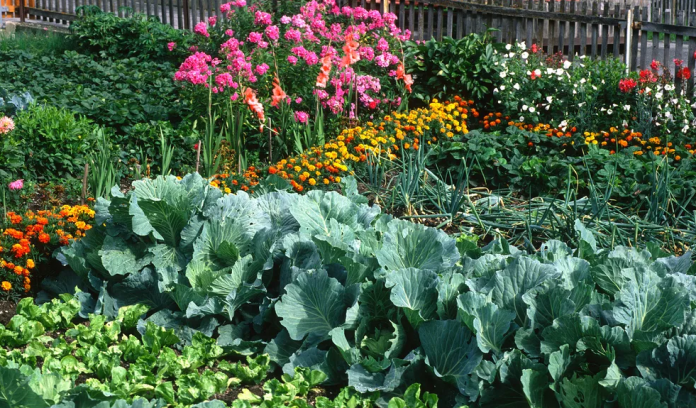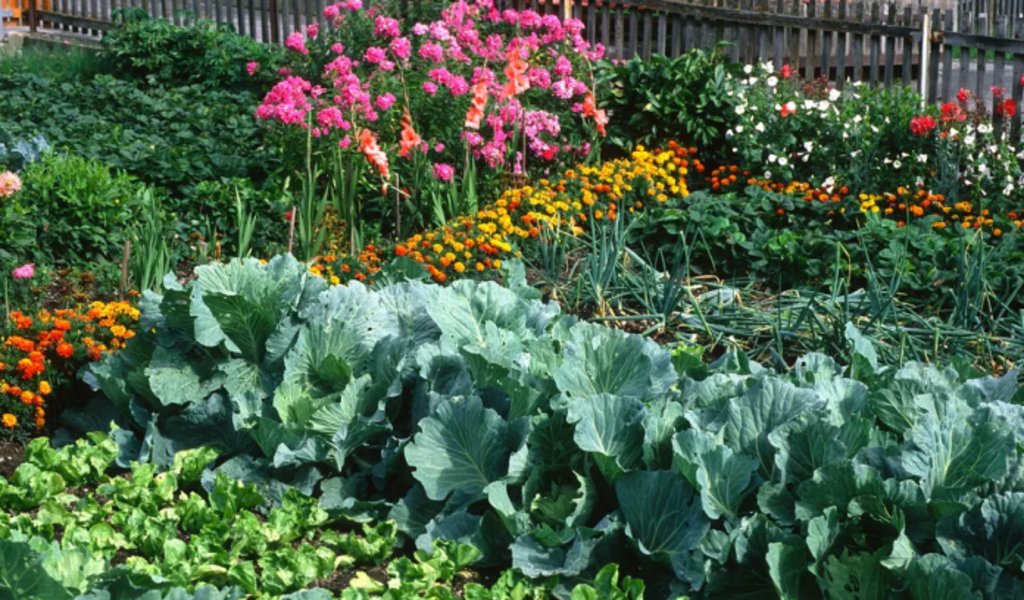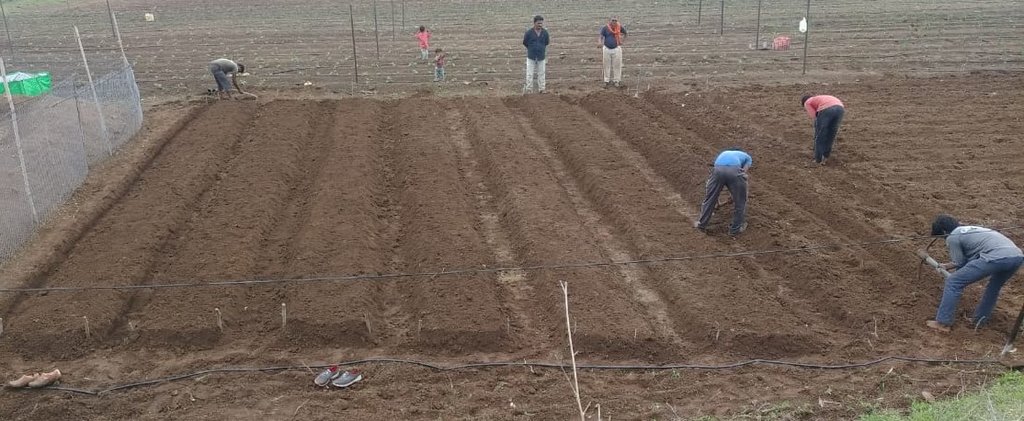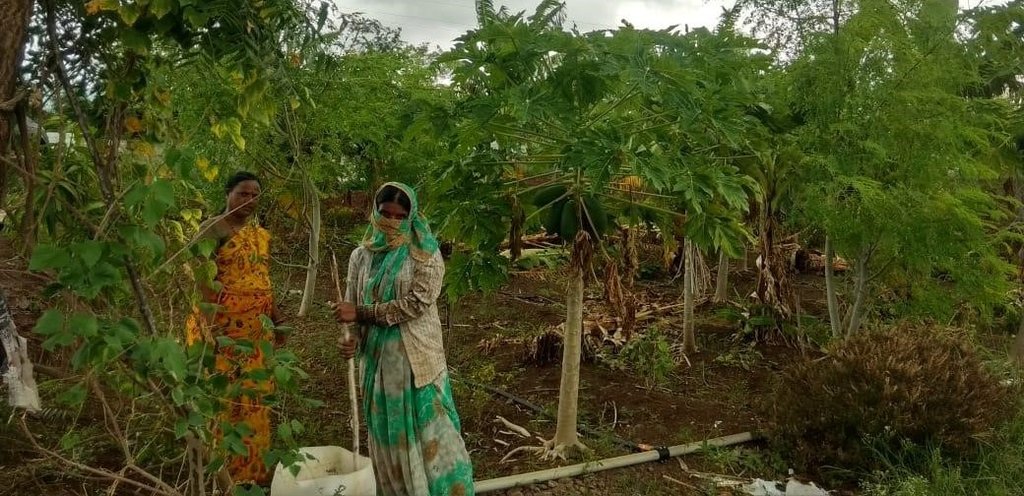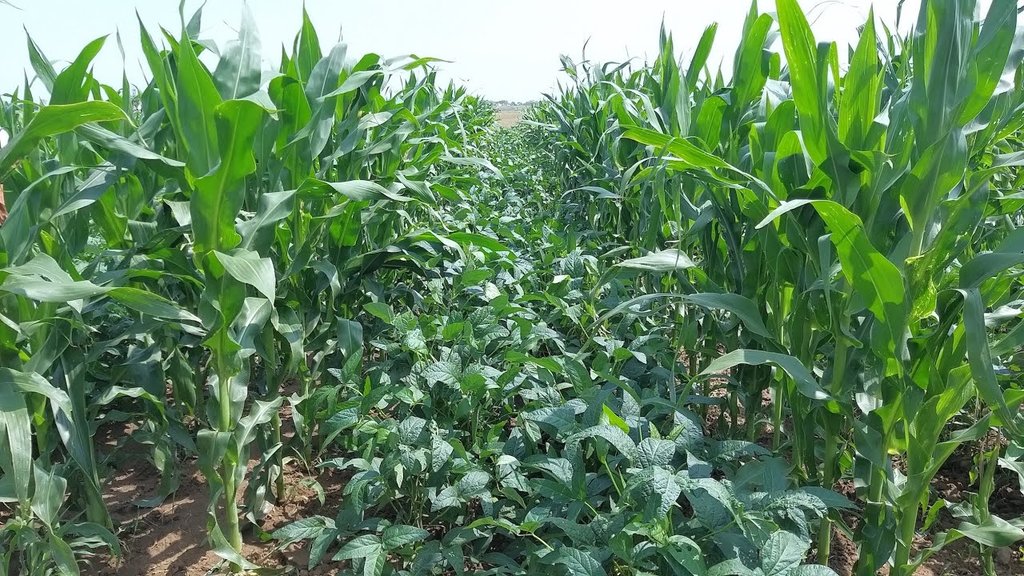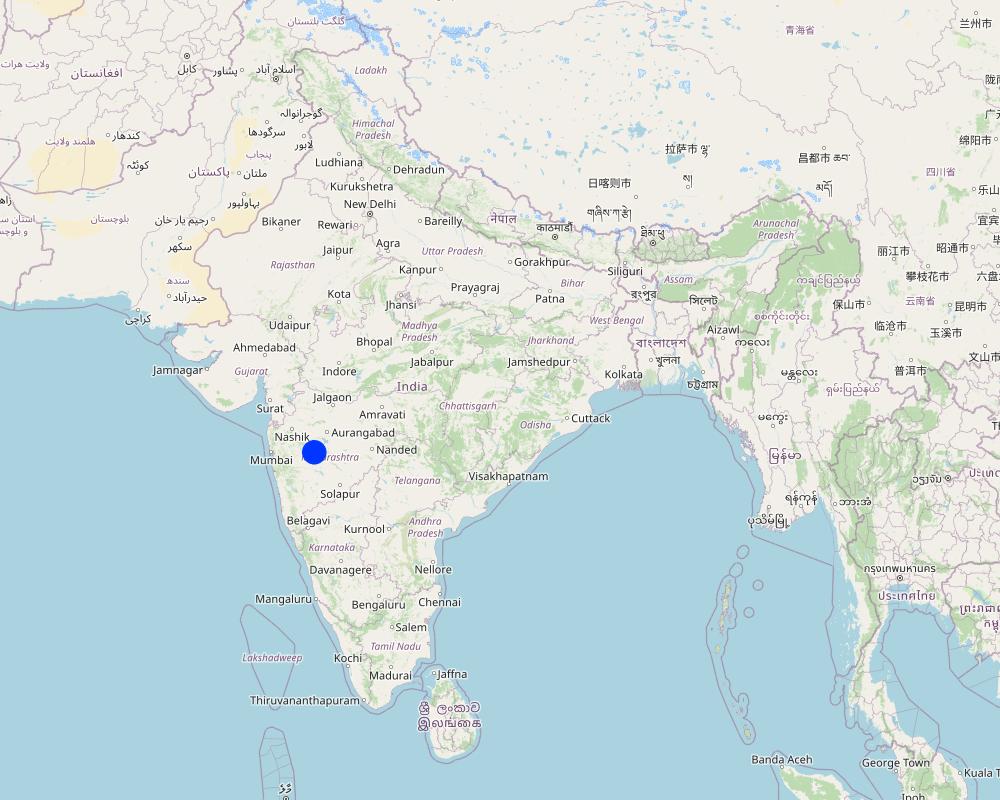Multilayer Farming Systems For Ensuring Food Diversity And Increasing Resilience [India]
- Creation:
- Update:
- Compiler: Santosh Gupta
- Editors: Noel Templer, Stephanie Katsir
- Reviewer: Udo Höggel
Mishrit kheti
technologies_6724 - India
- Full summary as PDF
- Full summary as PDF for print
- Full summary in the browser
- Full summary (unformatted)
- Multilayer Farming Systems For Ensuring Food Diversity And Increasing Resilience: Oct. 5, 2023 (inactive)
- Multilayer Farming Systems For Ensuring Food Diversity And Increasing Resilience: Nov. 20, 2023 (inactive)
- Multilayer Farming Systems For Ensuring Food Diversity And Increasing Resilience: April 17, 2024 (public)
View sections
Expand all Collapse all1. General information
1.2 Contact details of resource persons and institutions involved in the assessment and documentation of the Technology
Name of the institution(s) which facilitated the documentation/ evaluation of the Technology (if relevant)
Deutsche Gesellschaft für Internationale Zusammenarbeit (GIZ)Name of the institution(s) which facilitated the documentation/ evaluation of the Technology (if relevant)
Alliance Bioversity and International Center for Tropical Agriculture (Alliance Bioversity-CIAT) - KenyaName of the institution(s) which facilitated the documentation/ evaluation of the Technology (if relevant)
Ecociate Consultants (Ecociate Consultants) - India1.3 Conditions regarding the use of data documented through WOCAT
The compiler and key resource person(s) accept the conditions regarding the use of data documented through WOCAT:
Yes
1.4 Declaration on sustainability of the described Technology
Is the Technology described here problematic with regard to land degradation, so that it cannot be declared a sustainable land management technology?
No
Comments:
Multilayer farming is a farming practice that involves cultivating a mix of vegetables and fruits on a small piece of land. Additionally, by growing a variety of crops together, multilayer farming can increase yields and provide a more diverse range of foods for households.
2. Description of the SLM Technology
2.1 Short description of the Technology
Definition of the Technology:
Multilayer farming, also known as multi-tier farming, is a technique of intercropping crops of different heights, root and shoot patterns, and maturation times in small plots of land. This technique is cost-effective, easily adaptive, and participatory, providing a large number of food groups to farmers to improve their nutritional levels, providing insurance against crop failure, reducing pest and disease incidence, and improving soil properties and soil fertility conditions. Multilayer farming minimizes crop-weed competition, and soil erosion, and optimizes resource utilization resulting in higher returns and better nutritional value. It promotes sustainable agriculture, maintains a balanced diet, increases income per unit area, and reduces the risk of crop failure.
2.2 Detailed description of the Technology
Description:
Multilayer farming is an agricultural model that aims at achieving maximum production per unit area by utilizing water, manure, and land resources to their full potential. This method is based on the synergies between the different crops and plants planted on a given piece of land. This method is cost-effective and yields more benefits than other farming systems. By cultivating four to five crops with the same amount of fertilizer and water required for a single crop, farmers can increase their income, and multiple crops can be harvested yearly using the same piece of land.
Multilayer farming is based on scientific, ecological, and economic principles, promoting crop diversification, maximizing productivity, utilizing resources more efficiently, and promoting intensive input use. Moreover, it ensures the sustainability of farm resources and the environment in the long term.
The multilayer farming system mainly consists of an overstory of trees or shrubs with an understory of economic or forage crops. By incorporating these principles, farmers can achieve greater yields and financial success while promoting environmental sustainability.
As a part of the program's approach, WOTR (Watershed Organisation Trust, the project implementing partner trained women change-makers) to spread awareness among villagers about the importance of nutrition and a healthy diet. Since 2018, the active promotion of multilayer farming to address food and nutrition insecurity in Maharashtra is undertaken. As a result, 1124 plots across 150 villages in Maharashtra have adopted this unique farming method to enhance food and nutrition security.
The multilayer farming system involves several steps to ensure maximum productivity from the available resources.
1.The first step is land preparation, which involves applying 300 kg of cow dung or vermicompost along with one kg of Trichoderma powder per 36 x 36 feet plot. Trichoderma is a bio-fungicide that helps to prevent fungal infections in plants and roots.
2.Next, eight beds of 3 x 36 feet are prepared with 1.5 to 2 feet of space left in between. These beds need to be arranged in the North-South direction to ensure that plants receive adequate sunlight.
3.After preparing the bed, 1-foot deep channels are dug to drain excess water so ensuring that the crops are not waterlogged.
4.Finally, in the middle of each bed, vegetable and fruit crops are planted according to a crop planning chart. By planting a variety of crops in the same plot, the multilayer farming system ensures the effective utilization of resources and provides an even distribution of income and employment throughout the year by producing several off-season crops.
The multilayer farming system has numerous benefits that make it an effective and sustainable farming method. It makes effective use of soil, water, and other resources, reducing waste and increasing productivity. Additionally the system reduces climate-specific damage and enhances soil health, helping to maintain an ecological balance in the environment. The soil covered minimizes water loss due to soil evaporation, generating a higher income per unit area with an even distribution of income and employment throughout the year. The multilayer farming system generates jobs and allows for better utilization of labor while reducing the impacts of climate-specific hazards such as high-intensity rainfall, soil erosion, and landslides. Multilayer farming also utilizes soil moisture at different depths and solar energy at different heights, improving soil characteristics and adding organic matter to the soil. It reduces pests and disease infestation and provides micro-climate conditions which ensure better productivity of crops underneath. Overall, multilayer farming is a sustainable and efficient farming method that not only maximizes productivity but also enhances soil and environmental health while promoting economic and social well-being.
2.3 Photos of the Technology
General remarks regarding photos:
The images provide a visual representation of the essential steps followed by farmers to establish a successful multilayer farming system. These steps include land preparation, bed preparation, and planting a variety of crops in the same plot. The dates mentioned here are the dates of collection of these photos from the project implementing team as the photos were taken by different team members at different times.
2.5 Country/ region/ locations where the Technology has been applied and which are covered by this assessment
Country:
India
Region/ State/ Province:
Maharashtra
Further specification of location:
Ahmednagar
Specify the spread of the Technology:
- applied at specific points/ concentrated on a small area
Is/are the technology site(s) located in a permanently protected area?
No
Comments:
In Maharastra State, there are different districts where multilayer farming plots are established such as Ahmednagar, Satara, and Dhule
Map
×2.6 Date of implementation
Indicate year of implementation:
2018
2.7 Introduction of the Technology
Specify how the Technology was introduced:
- during experiments/ research
- through projects/ external interventions
Comments (type of project, etc.):
The intervention is a result of experiments and research by WOTR and other agencies at different project locations
3. Classification of the SLM Technology
3.1 Main purpose(s) of the Technology
- improve production
- reduce, prevent, restore land degradation
- adapt to climate change/ extremes and its impacts
- create beneficial economic impact
- create beneficial social impact
- Ensure nutritional security
3.2 Current land use type(s) where the Technology is applied
Land use mixed within the same land unit:
No

Cropland
- Annual cropping
Annual cropping - Specify crops:
- cereals - sorghum
- cereals - wheat (winter)
- Sugarcane, Horticulture crops like Pomegranate, Guava, Mango etc, Onion, pulses
Number of growing seasons per year:
- 2
Specify:
In places where irrigation source is availbe the growing seasons vary between 2 to 3
Is intercropping practiced?
Yes
Is crop rotation practiced?
Yes
If yes, specify:
In places where irrigation is available, farmers grow Kharif crops (summer crops) followed by Rabi crops (winter crops).
Comments:
The majority of farmers in various regions tend to practice mono-cropping due to rainfall variability and less rainfall in the region. However, in places where an irrigation source is available, farmers tend to grow second crops in the Rabi season or go for horticulture crops such as fruits and vegetables.
3.3 Has land use changed due to the implementation of the Technology?
Has land use changed due to the implementation of the Technology?
- Yes (Please fill out the questions below with regard to the land use before implementation of the Technology)
Land use mixed within the same land unit:
Yes
Specify mixed land use (crops/ grazing/ trees):
- Agroforestry

Cropland
- Annual cropping
- Tree and shrub cropping
- Horticulture Crops
Annual cropping - Specify crops:
- flower crops
- vegetables - other
- drumstick, marigold, radish, dolichos beans, coriander, spinach, fenugreek, dill, okra, brinjal, tomato, red pumpkin, maize, cowpea, castor, ridge gourd
Tree and shrub cropping - Specify crops:
- mango, mangosteen, guava
- papaya
- Sapota
Is intercropping practiced?
Yes
If yes, specify which crops are intercropped:
In multi-cropping systems, fruits and vegetables are planted in a systematically planned manner using crop planning charts. This approach ensures that the growth of plants complements each other, providing adequate nutrition for the family throughout the year.
Is crop rotation practiced?
Yes
If yes, specify:
The combination of vegetables is selected based on the suitability to climate conditions as tomatoes are grown during the winter season, beans during the summer seasons etc.
Comments:
The land was mostly converted from mono-cropping systems to a multi-cropping system
3.4 Water supply
Water supply for the land on which the Technology is applied:
- mixed rainfed-irrigated
Comments:
Multi-cropping systems involve covering the soil with crops throughout the year, which helps to reduce evaporation losses. In addition, irrigation is provided using drip or sprinkler systems to minimize water losses. This approach not only conserves water but also helps to maintain soil moisture levels, leading to higher yields and improved plant health. By adopting these practices, farmers can improve the sustainability and resilience of their agricultural systems.
3.5 SLM group to which the Technology belongs
- improved ground/ vegetation cover
- irrigation management (incl. water supply, drainage)
- home gardens
3.6 SLM measures comprising the Technology

agronomic measures
- A1: Vegetation/ soil cover
- A2: Organic matter/ soil fertility
- A5: Seed management, improved varieties

vegetative measures
- V1: Tree and shrub cover

management measures
- M1: Change of land use type
- M4: Major change in timing of activities
Comments:
1. Effective utilization of natural resources
2. Reduces climate-specific damage & enhances soil health and reduces water loss due to evaporation from the soil
3. The income per unit area increases substantially with this system and multilayer farming ensures the yield of some crops throughout the year
4. Utilizes the soil moisture well at different depths of soil and effectively utilizes solar energy at different heights
5. Improve the soil characteristics and adds organic matter to the soil
6. Provides a partial guarantee against the market glut of a single commodity and the efficient cultivation of a range of products is possible
3.7 Main types of land degradation addressed by the Technology

physical soil deterioration
- Ps: subsidence of organic soils, settling of soil

biological degradation
- Bc: reduction of vegetation cover
- Bq: quantity/ biomass decline
- Bs: quality and species composition/ diversity decline
- Bp: increase of pests/ diseases, loss of predators
Comments:
Multilayer farming covers the soil throughout the year with crops, fruits, and vegetables. The micro-climate enables diversified crops to grow together and provide nutrition to the family through out the year. The year around soil cover reduces soil erosion by wind and flood.
3.8 Prevention, reduction, or restoration of land degradation
Specify the goal of the Technology with regard to land degradation:
- prevent land degradation
- reduce land degradation
Comments:
Multilayer farming improves soil fertility by improving the microbial activities in the soil as the ecosystem of different root zones, plants and organic matter coupled with organic inputs creates a healthy plant environment
4. Technical specifications, implementation activities, inputs, and costs
4.2 General information regarding the calculation of inputs and costs
Specify how costs and inputs were calculated:
- per Technology area
Indicate size and area unit:
1
If using a local area unit, indicate conversion factor to one hectare (e.g. 1 ha = 2.47 acres): 1 ha =:
ha
other/ national currency (specify):
INR
If relevant, indicate exchange rate from USD to local currency (e.g. 1 USD = 79.9 Brazilian Real): 1 USD =:
80.0
Indicate average wage cost of hired labour per day:
200
4.3 Establishment activities
| Activity | Timing (season) | |
|---|---|---|
| 1. | Land Preperation | June |
| 2. | Preperation of beds for seed sowing | June |
| 3. | Sowing of seeds for fruits | Early June |
| 4. | Fencing of the field | Before the sowing |
Comments:
Farmers can use local resources such as Bamboo or other crop residues for fencing purposes as well. Land needs to be prepared before the onset of monsoon (during the summer season). Once a multilayer plot is established there is no need to prepare the land as well.
4.4 Costs and inputs needed for establishment
| Specify input | Unit | Quantity | Costs per Unit | Total costs per input | % of costs borne by land users | |
|---|---|---|---|---|---|---|
| Labour | Land preparation | person days | 2.0 | 200.0 | 400.0 | 100.0 |
| Labour | Preperation of beds for sowing | Person days | 3.0 | 200.0 | 600.0 | 100.0 |
| Equipment | Fencing material | Lumpsum | 1.0 | 5000.0 | 5000.0 | 100.0 |
| Plant material | Seeds for fruit trees (seeds and planting material) | Plant | 100.0 | 50.0 | 5000.0 | 100.0 |
| Fertilizers and biocides | Fram yard manure | Tons | 10.0 | 600.0 | 6000.0 | 100.0 |
| Other | Miscellaneous | 1.0 | 2000.0 | 2000.0 | 100.0 | |
| Total costs for establishment of the Technology | 19000.0 | |||||
| Total costs for establishment of the Technology in USD | 237.5 | |||||
Comments:
Costs towards labour, farm yard manure and sometimes seeds are internally arranged by the land users thus there may not be any cost to pay.
4.5 Maintenance/ recurrent activities
| Activity | Timing/ frequency | |
|---|---|---|
| 1. | Sowing of seeds | June-July/October-November/April/March/April |
| 2. | Application of organic manures | Across the year at critical growth stages |
| 3. | Irrigation | Across the year at critical growth stages |
| 4. | Bio-inputs | Based on the plant needs |
| 5. | Harvesting of leafy vegetables, fruits, fodder and other produces | Multiple plucking during the year |
| 6. | Sales of farm produces | Multiple times during the year |
Comments:
Maintenance activities vary farmers to farmers depending upon the kind of fruits and vegetables planted, availability of resources and land area under cultivation
4.6 Costs and inputs needed for maintenance/ recurrent activities (per year)
| Specify input | Unit | Quantity | Costs per Unit | Total costs per input | % of costs borne by land users | |
|---|---|---|---|---|---|---|
| Labour | Sowing of seeds | Person days | 8.0 | 200.0 | 1600.0 | 100.0 |
| Labour | Application of FYM and other inputs | Person days | 5.0 | 200.0 | 1000.0 | 100.0 |
| Labour | Maintenance and monitoring of the field | Person days | 50.0 | 100.0 | 5000.0 | 100.0 |
| Labour | Harvesting | Person days | 20.0 | 200.0 | 4000.0 | 100.0 |
| Plant material | Seeds and planting material | Kg | 0.25 | 1000.0 | 250.0 | 100.0 |
| Fertilizers and biocides | Farm yard manure and other inputs | Tons | 5.0 | 750.0 | 3750.0 | 100.0 |
| Other | Other cost | Lumpsum | 1.0 | 1000.0 | 1000.0 | 100.0 |
| Total costs for maintenance of the Technology | 16600.0 | |||||
| Total costs for maintenance of the Technology in USD | 207.5 | |||||
Comments:
These farms are mostly managed by the farmers themselves without hiring any additional labour. Thus, labour cost is not something farmers need to pay for.
4.7 Most important factors affecting the costs
Describe the most determinate factors affecting the costs:
1. Availability of family labour to manage the field operations
2. Availability of dairy animals at the household level to meet the FYM needs
5. Natural and human environment
5.1 Climate
Annual rainfall
- < 250 mm
- 251-500 mm
- 501-750 mm
- 751-1,000 mm
- 1,001-1,500 mm
- 1,501-2,000 mm
- 2,001-3,000 mm
- 3,001-4,000 mm
- > 4,000 mm
Specify average annual rainfall (if known), in mm:
561.00
Specifications/ comments on rainfall:
Deccan Plateau, Hot Semi-Arid Eco-Region as per the ICAR classification of Ecological Zone
Indicate the name of the reference meteorological station considered:
https://krishi.icar.gov.in/jspui/bitstream/123456789/30264/1/MH14.pdf
Agro-climatic zone
- semi-arid
Length of growing period: less than 90 days
Rainy days: 44
5.2 Topography
Slopes on average:
- flat (0-2%)
- gentle (3-5%)
- moderate (6-10%)
- rolling (11-15%)
- hilly (16-30%)
- steep (31-60%)
- very steep (>60%)
Landforms:
- plateau/plains
- ridges
- mountain slopes
- hill slopes
- footslopes
- valley floors
Altitudinal zone:
- 0-100 m a.s.l.
- 101-500 m a.s.l.
- 501-1,000 m a.s.l.
- 1,001-1,500 m a.s.l.
- 1,501-2,000 m a.s.l.
- 2,001-2,500 m a.s.l.
- 2,501-3,000 m a.s.l.
- 3,001-4,000 m a.s.l.
- > 4,000 m a.s.l.
Indicate if the Technology is specifically applied in:
- not relevant
Comments and further specifications on topography:
Physiographically the district can be broadly divided in four major characteristic landforms viz., hill and ghat section (7.6% area); foothill zone (19.4% area); plateau (3.71% area) and plains (occupy 69.30% area). The intervention has been implemented in different villages of the district.
5.3 Soils
Soil depth on average:
- very shallow (0-20 cm)
- shallow (21-50 cm)
- moderately deep (51-80 cm)
- deep (81-120 cm)
- very deep (> 120 cm)
Soil texture (topsoil):
- fine/ heavy (clay)
Soil texture (> 20 cm below surface):
- fine/ heavy (clay)
Topsoil organic matter:
- low (<1%)
If available, attach full soil description or specify the available information, e.g. soil type, soil PH/ acidity, Cation Exchange Capacity, nitrogen, salinity etc.
The soil types of the district are broadly divided into four categories namely coarse shallow soil; medium black soil; deep black soil and reddish soil occupying about 38, 41, 13 and 8 percent of the cultivated area respectively. In the first two categories, soil moisture is the predominant limiting factor affecting productivity of crops particularly under rainfed condition. (source-http://www.kvk.pravara.com/pages/District%20Profile/District%20Profile.htm)
5.4 Water availability and quality
Ground water table:
> 50 m
Water quality (untreated):
good drinking water
Water quality refers to:
both ground and surface water
Is water salinity a problem?
No
Is flooding of the area occurring?
No
Comments and further specifications on water quality and quantity:
On an average 26.3 per cent of the cultivated area is under irrigation, out of which 71.5 per cent is under well irrigation (including lift irrigation) and remaining area is under canal irrigation. (http://www.kvk.pravara.com/pages/District%20Profile/District%20Profile.htm)
The overall stage of ground water development for the district is quite high i.e., 79.8%. Further ground water development is not recommended without adhering to the precautionary measures i.e., artificial recharge to augment the ground water resources and adoption of ground water management practices. Ground water quality in the wells
monitored by the concerned authorities in the district is affected because of high NO3 concentrations. (http://cgwb.gov.in/District_Profile/Maharashtra/Ahmadnagar.pdf)
5.5 Biodiversity
Species diversity:
- low
Habitat diversity:
- low
Comments and further specifications on biodiversity:
The majority of the area is under farming. Mono cropping is the generally practiced by farmers.
5.6 Characteristics of land users applying the Technology
Sedentary or nomadic:
- Sedentary
Market orientation of production system:
- mixed (subsistence/ commercial)
Off-farm income:
- 10-50% of all income
Relative level of wealth:
- poor
- average
Individuals or groups:
- individual/ household
- groups/ community
Level of mechanization:
- manual work
- mechanized/ motorized
Gender:
- women
- men
Age of land users:
- youth
- middle-aged
Indicate other relevant characteristics of the land users:
Most land users covered during the project are small and marginal farmers with land up to 2 ha. The focus has been on women farmers to ensure the self-consumption of diverse food groups harvested from the multi-layer plots. The land users belong to a heterogeneous group of individuals coming from different social backgrounds and caste segments.
5.7 Average area of land used by land users applying the Technology
- < 0.5 ha
- 0.5-1 ha
- 1-2 ha
- 2-5 ha
- 5-15 ha
- 15-50 ha
- 50-100 ha
- 100-500 ha
- 500-1,000 ha
- 1,000-10,000 ha
- > 10,000 ha
Is this considered small-, medium- or large-scale (referring to local context)?
- small-scale
Comments:
Nearly 61% of farmers fall into the category of landholding less than 1 hectare. (https://mahades.maharashtra.gov.in/files/publication/dsa_ahmednagar_2014.pdf)
5.8 Land ownership, land use rights, and water use rights
Land ownership:
- individual, titled
Land use rights:
- individual
Water use rights:
- open access (unorganized)
Are land use rights based on a traditional legal system?
No
5.9 Access to services and infrastructure
health:
- poor
- moderate
- good
education:
- poor
- moderate
- good
technical assistance:
- poor
- moderate
- good
employment (e.g. off-farm):
- poor
- moderate
- good
markets:
- poor
- moderate
- good
energy:
- poor
- moderate
- good
roads and transport:
- poor
- moderate
- good
drinking water and sanitation:
- poor
- moderate
- good
financial services:
- poor
- moderate
- good
Comments:
The district is one among the progressive districts of Maharashtra and is well connected with a good network of roads and railways.
6. Impacts and concluding statements
6.1 On-site impacts the Technology has shown
Socio-economic impacts
Production
crop production
Comments/ specify:
Round the year farm, produce of vegetables and fruits is available from multilayer fields. The data is based on the observation of land users, there has not been any study to assess possible qualitative improvements
product diversity
Comments/ specify:
Farmers grow multilayer crops in smaller land sizes thus increasing the diversity of the products and the nutrition quality at the household level
production area
Comments/ specify:
Efficient use of land by growing Multilayer Farming led to efficient utilization of the small farm plots
Water availability and quality
irrigation water availability
Comments/ specify:
The use of micro irrigation led to a more efficient use of the same quantity of water allowing for the irrigation of land for a longer duration
Income and costs
expenses on agricultural inputs
Comments/ specify:
Organic inputs such as cow dung, cow urine, etc were used. This reduced the cost of the inputs.
farm income
Comments/ specify:
Income from farms increased as farm yields increased. Excess produce of vegetables and fruits is sold in the market.
diversity of income sources
Comments/ specify:
As the farmers shift from mono-crop to multilayer cropping. This reduces the risk of crop failure faced by mono-crop farmers.
Other socio-economic impacts
Intake of Nutritional Food
Comments/ specify:
Intake of nutritional food increased as the availability of fruits and vegetables no longer depended exclusively on markets
Socio-cultural impacts
food security/ self-sufficiency
health situation
Comments/ specify:
Nutritional food available for consumption
Ecological impacts
Water cycle/ runoff
evaporation
Comments/ specify:
Crop cover for a longer duration over the soil, reducing evaporation losses
Soil
soil moisture
Comments/ specify:
Use of organic practices and covering the soil with crop and dry crop litter for a longer duration increased the soil moisture retention capacity
soil cover
soil organic matter/ below ground C
Comments/ specify:
Bio-inputs and dry crop litter added to the soil increased the soil organic matter
Biodiversity: vegetation, animals
biomass/ above ground C
plant diversity
Comments/ specify:
Crop diversity: vegetables and fruit crops are grown
pest/ disease control
Comments/ specify:
As multiple crops are grown, pest and disease infestation is reduced
Specify assessment of on-site impacts (measurements):
The impact areas indicated in the document are based on the experience and observations of the land users and field-level workers of implementing agencies. There has not been any scientific study to measure the quantitative impact of the intervention.
6.3 Exposure and sensitivity of the Technology to gradual climate change and climate-related extremes/ disasters (as perceived by land users)
Comments:
The micro-climate of the multilayered farm is maintained, enabling the crops to grow well
6.4 Cost-benefit analysis
How do the benefits compare with the establishment costs (from land users’ perspective)?
Short-term returns:
positive
Long-term returns:
positive
How do the benefits compare with the maintenance/ recurrent costs (from land users' perspective)?
Short-term returns:
positive
Long-term returns:
positive
6.5 Adoption of the Technology
- 1-10%
Of all those who have adopted the Technology, how many did so spontaneously, i.e. without receiving any material incentives/ payments?
- 91-100%
6.6 Adaptation
Has the Technology been modified recently to adapt to changing conditions?
Yes
If yes, indicate to which changing conditions it was adapted:
- changing markets
Specify adaptation of the Technology (design, material/ species, etc.):
The Vegetable and fruits crops are modified based on the Household requirement
6.7 Strengths/ advantages/ opportunities of the Technology
| Strengths/ advantages/ opportunities in the land user’s view |
|---|
| Diversified vegetables and fruits available for household consumption |
| Increase in household income, as the excess produce is sold in the market and also reduced dependency on markets to purchase fruits and vegetables |
| Small farm plot (1300 sq. ft) is utilized under multilayer farming, remaining farmland is available for cereal, etc |
| Strengths/ advantages/ opportunities in the compiler’s or other key resource person’s view |
|---|
| Water use efficiency because of the use of micro irrigation and reduction of evaporation as the crops and dry matter cover the soil |
| A good micro-climate of the multilayer farm plot is maintained |
| Availability of a good range of food groups to farmers may lead to improvement in nutritional parameters especially for women and children |
| Improved soil health due to mixed cropping system and enhancement soil microbial activities |
6.8 Weaknesses/ disadvantages/ risks of the Technology and ways of overcoming them
| Weaknesses/ disadvantages/ risks in the land user’s view | How can they be overcome? |
|---|---|
| Labor engagement throughout the year | Mechanization suitable for small farm plots |
| Availability of farm yard manure to ensure cultivation following natural farming practices | Promotion of animal husbandry (dairy) in convergence with the government departments |
| Weaknesses/ disadvantages/ risks in the compiler’s or other key resource person’s view | How can they be overcome? |
|---|---|
| The produce from multilayer farming is diversified and comes in small quantities. Therefore the selling of these small quantities of produce is done in the local market. | Creation of farmers' collectives for selling larger amounts of produce in the market |
| Availability of irrigation is important to ensure the sustainability of intervention | Some water based enterprises can be developed to support the farmers not have irrigation facilities |
7. References and links
7.1 Methods/ sources of information
- interviews with land users
5
- compilation from reports and other existing documentation
4
When were the data compiled (in the field)?
09/04/2023
7.3 Links to relevant online information
Title/ description:
How is multilayer farming done?
URL:
https://wotr.org/2020/07/18/how-multilayer-farming-is-done/
Title/ description:
Enhancing Household Food and Nutrition Security With Multilayer Farming
URL:
https://www.csrmandate.org/enhancing-household-food-and-nutrition-security-with-multilayer-farming/
Title/ description:
Kitchen Garden, Multilayer Farming Boost Food Security in Maharashtra
URL:
https://wotr.org/2020/05/07/kitchen-garden-multilayer-farming-boost-food-security-in-maharashtra-2/
Links and modules
Expand all Collapse allLinks
No links
Modules
No modules


